高中英语情态动词详解(必修三unit1-2)教学文案
人教版高中英语必修三语法总结

人教版高中英语必修三语法总结高中英语必修三语法主要考点有情态动词、名词性从句、同位语从句等,下面是具体的高中英语必修三语法,仅供参考。
1英语必修三有哪些语法要学考点一情态动词(unit1,unit2)一、情态动词的特点:1.没有人称和数的变化。
2.有些情态动词有过去式的变化:e.g.will→would,can→could,may→might,dare→dared二、情态动词的否定式:情态动词+not+动词原形cannot:can’t,mustnot:mustn’t,neednot:needn’t三、情态动词的用法及相互区别,是考试的内容之一1.can,beabletobeableto表示经过努力后,能够做到;beableto有多种形式的变化。
can1).表示体力或脑力方面的能力;2).表示允许、可能性。
could是can的过去式,表示过去有能力及过去存在的可能性;用于疑问句表示委婉地提出问题。
1)Thefirespreadthroughthehotelveryquicklybuteveryone____getout.(NMET97)A.hadtoB.wouldC.couldD.wasableto2)-Willyoustayforlunch?-Sorry,__.Mybrotheriscomingtoseeme.(NMET99)A.Imustn’tB.Ican’tC.Ineedn’tD.Iwon’t2.may表示询问或说明一件事可不可做;表示某事有可能发生。
might是may的过去式;用在疑问中比may委婉、客气。
1)-MayItakethisbookoutofthereading-room?-No,youmustn’t.(Yes,youmay.)2)-MightImakeasuggestion?-Yes,youmay.3.must1).表示必须要做的事:必须2)表示很有把握的推断:一定,准是。
have(has)to:have(has)gotto必须,不得不。
高一英语教案高一英语必修3第2单元导学案情态动词(II)_0449文档

2020高一英语教案高一英语必修3第2单元导学案情态动词(II)_0449文档EDUCATION WORD高一英语教案高一英语必修3第2单元导学案情态动词(II)_0449文档前言语料:温馨提醒,教育,就是实现上述社会功能的最重要的一个独立出来的过程。
其目的,就是把之前无数个人有价值的观察、体验、思考中的精华,以浓缩、系统化、易于理解记忆掌握的方式,传递给当下的无数个人,让个人从中获益,丰富自己的人生体验,也支撑整个社会的运作和发展。
本文内容如下:【下载该文档后使用Word打开】导学案4情态动词(ii)一、oughtto应该,应当其否定“oughtnotto”或“oughtn’tto”(1)用于第一人称,表有责任或有必要做某事。
weoughttobemorecarefulwithourhomework.(2)用于二、三人称,表建议或劝告。
yououghttofollowyourteacher’sadvice.sheoughtnottogoalone .(3)oughtto+havedone:本该……i’msorry.iought tohavetoldyouthismorning.对不起,我本该今天早上告诉你的。
二、haveto/don’thaveto/mustn’t(1)haveto=havegotto 必须,不得不(有人称和数、时态的变化)hehastoworkonthefarmallday.他不得不在农场工作一整天。
(2)don’thaveto不必……youdon’thavetobuyacomputer.(3)mustn’t禁止,不许youmustn’tsleepinclass!三、need需要,必要(既可以作情态动词,也可以作实义动词,但用法不同)(1)作为情态动词,need通常用于否定句和疑问句①youneedn’tbuythebook..②――needhedohishomeworkfirst?――yes,hemust!(no,heneedn’t)(2)need作为实义动词时,通常用法是:sb/sthneedtodo(表主动)weneedtotellhimthetruth.sb/sthneeddoing/tobedone(表被动)mycarneedsrepairing./mycarneedstoberepairdsbneedsth某人需要……maryneedsyourhelp.三、情态动词+havedone1.musthavedone推测过去“肯定……”hemusthaveplayedcomputergameslastnight.2may/might havedone推测过去“也许……”hemighthaveknowntheanswertothequestion.3.(1)could havedone用于疑问句时,表示推测过去“可能……?”couldhehavefinishedthetask?他可能把任务完成了吗?(2)couldhavedone用于肯定句时,表“能够做而没有做”icouldhavefinishedtheworkonmyown.我本能够独自完成工作.4.(1)shouldhavedone本应该做而没有做youshouldhavestudiedhard.(2)shouldn’thavedone本不该做而做了youshouldn’thavetoldlies.5.oughttohavedone:本该做而没做 6.needn’thavedone本不必……本没必要……youneedn’thavetoldmethene ws.。
高一英语英语必修3Unit1语法情态动词课件精选

高一英语英语必修3Unit1语法情态动词课件精选一、教学内容本节课选自高一英语必修3 Unit1的语法情态动词部分。
具体内容包括:1. 章节内容:Unit1 Festivals around the world2. 详细内容:情态动词的用法,包括can, may, must, need, should等;情态动词在肯定句、疑问句和否定句中的使用;情态动词与动词原形的搭配。
二、教学目标1. 掌握情态动词的基本用法,能够正确运用情态动词表达推测、许可、能力等。
2. 能够在肯定句、疑问句和否定句中正确运用情态动词。
3. 能够通过本节课的学习,了解并尊重世界各地的文化差异。
三、教学难点与重点1. 教学难点:情态动词的用法区别,如can和be able to的用法区分,情态动词在疑问句中的用法等。
2. 教学重点:掌握情态动词的基本用法,能够在实际语境中正确运用。
四、教具与学具准备1. 教具:多媒体课件、黑板、粉笔。
2. 学具:学生用书、练习册、笔记本。
五、教学过程1. 导入:通过展示世界各地节日的图片,引导学生谈论自己了解的节日,引入新课。
2. 讲解:结合教材,详细讲解情态动词的用法,通过例句、对比等方式帮助学生理解。
3. 实践:设计实践情景,让学生运用情态动词进行对话练习。
4. 例题讲解:分析并讲解教材中的例题,帮助学生巩固所学知识。
5. 随堂练习:布置教材中的练习题,及时检查学生的学习效果。
六、板书设计1. 情态动词的基本用法can/may/must/need/should + 动词原形2. 情态动词在肯定句、疑问句和否定句中的使用3. 情态动词的用法区别七、作业设计1. 作业题目:a. 根据所学情态动词,完成下列句子。
b. 运用情态动词,编写一段关于节日的对话。
2. 答案:a. 例如:He can speak English fluently. / Can I go to the party?b. 例如:A: Can you tell me about the Spring Festival?B: Sure. The Spring Festival is the most important festival in China. We usually celebrate it with our families. We must clean our houses and make delicious food.八、课后反思及拓展延伸1. 反思:关注学生在课堂上的表现,及时了解他们对情态动词用法的掌握程度,调整教学方法。
高中英语必修三教学课件:Unit+1+情态动词

4. It is possible he may have called while we were out. ( 现在完成型may have called) 当我们出门时,他有可能会打电话来。
5. Sam might have taken the money , but it seems unlikely. (过去完成式型------might have taken) 钱也许会是Sam拿走的,但又不太像。
我一直没能和她联系上。 2) 通常can 和 be able to 可以互换 例如:He will come if he can. 如果可能的话,他一定会来。
can 和could表示“可能” “推测”
1. He can’t be at home. (否定句) 他不可能在家。
2. Can the news be true? 这消息可能是真的吗? 3. Anybody can make a mistake. (只表示理论上的可能性) 任何人都可能犯错误。
6. If you took some exercise, you might not be so fat.(might用于条件句) 要是你锻炼锻炼,可能不会这样胖。
7. Electric irons could be dangerous; they might give you a severe shock.
4. At that time we thought the story could not be true. (表示过去的可能性) 那时我们认为所说的故事不可能是真的。
5. An accident can happen if you do this. (表示事情 肯定会发生) ------如果你这样做,可能会发生以外。
必修3Unit1情态动词语法ppt课件
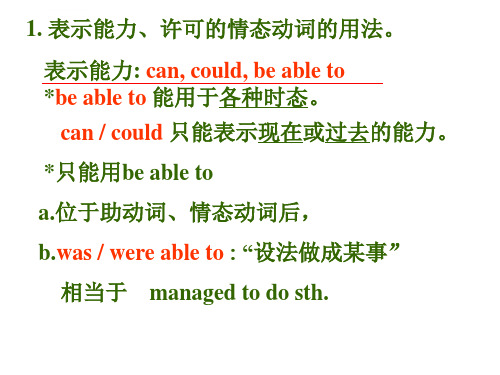
例1:---Could I borrow your dictionary?
---Yes, of course you____.
A. might
B. will
C. can
D. should
析:选C。该句用can的委婉表达式could 来征 求对方意见,could 和might通用,但回答 时必须要用can或may,因此该题不选A.
火灾袭来时要迅速疏散逃生,不可蜂 拥而出 或留恋 财物, 要当机 立断, 披上浸 湿的衣 服或裹 上湿毛 毯、湿 被褥勇 敢地冲 出去
should
should
should用于构成将来时是助动词。should用于表示 “应当”“猜测”是情态动词。
(1) 表示义务,责任,意为“应当” 。
You should pay for your taxes.
析:选A。根据规定need用于一般疑问句 作肯定回答应换成must,而作否定回答 时,使用need的否定式needn’t。
火灾袭来时要迅速疏散逃生,不可蜂 拥而出 或留恋 财物, 要当机 立断, 披上浸 湿的衣 服或裹 上湿毛 毯、湿 被褥勇 敢地冲 出去
7.
shall和should的用法
• Shall
火灾袭来时要迅速疏散逃生,不可蜂 拥而出 或留恋 财物, 要当机 立断, 披上浸 湿的衣 服或裹 上湿毛 毯、湿 被褥勇 敢地冲 出去
例1:---Must I start at once?
---No, you____.
A. needn’t
B. mustn’t
C. can’t
D. won’t
析:A。由语境可知该答句表示“不必”, 而mustn’t表示“不准、禁止”,不符合语 境,显然应使用needn’t表示“不必”,但 肯定句回答继续用must。
人教版必修三unit1 情态动词公开课课件

can/could: 情态动词的用法:
1. can 一般表示与生俱来的能力或 者一种客观可能性,还可以表示请 求和允许 。
Man can not live without air. Learning English _____ can be difficult.
Can _______ I use your bike?
can表示与生俱来的能力或一种客观可能,而 be able to更加强调通过后天的学习和努力获 得的能力,或者在某个客观的场合和背景下, 能做到的事情。
can/be able to区别:
1.A big fire broke out in ABC hotel yesterday. Luckily, everyone was able to run out of __________ the building. 2. She speak both English and French.
3).At last , they ___________escape from the fire.
1. –What sort of house do you want to have? Something big? C --Well, it _________ be big--that’s not important。 A. mustn’t B. needn’t C. can’t D. won’t
4.It could be very interesting to go out for a drive._____.
2.选词填空:can , be able to
1).He ____give you some advice on how to learn English . 2).The baby will ___________walk in a few months.
高一英语必修三Unit1语法教案
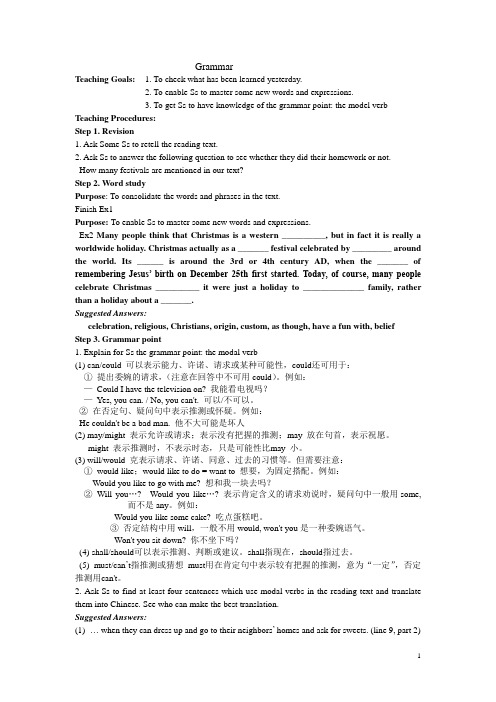
GrammarTeaching Goals: 1. To check what has been learned yesterday.2. To enable Ss to master some new words and expressions.3. To get Ss to have knowledge of the grammar point: the model verb Teaching Procedures:Step 1. Revision1. Ask Some Ss to retell the reading text.2. Ask Ss to answer the following question to see whether they did their homework or not.How many festivals are mentioned in our text?Step 2. Word studyPurpose: To consolidate the words and phrases in the text.Finish Ex1Purpose: To enable Ss to master some new words and expressions.Ex2 Many people think that Christmas is a western __________, but in fact it is really a worldwide holiday. Christmas actually as a _______ festival celebrated by _________ around the world. Its ______ is around the 3rd or 4th century AD, when the _______ of remembering Jesus’ birth on December 25th first started. Today, of course, many people celebrate Christmas __________ it were just a holiday to ______________ family, rather than a holiday about a _______.Suggested Answers:celebration, religious, Christians, origin, custom, as though, have a fun with, beliefStep 3. Grammar point1. Explain for Ss the grammar point: the modal verb(1) can/could 可以表示能力、许诺、请求或某种可能性,could还可用于:①提出委婉的请求,(注意在回答中不可用could)。
高一英语英语必修3Unit1语法情态动词课件精选
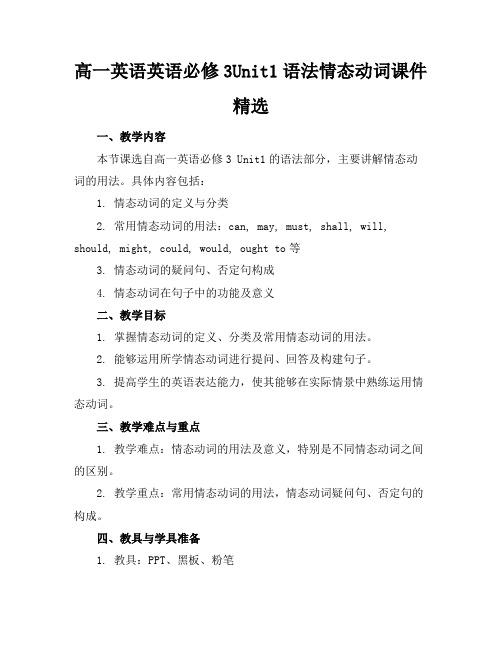
高一英语英语必修3Unit1语法情态动词课件精选一、教学内容本节课选自高一英语必修3 Unit1的语法部分,主要讲解情态动词的用法。
具体内容包括:1. 情态动词的定义与分类2. 常用情态动词的用法:can, may, must, shall, will, should, might, could, would, ought to等3. 情态动词的疑问句、否定句构成4. 情态动词在句子中的功能及意义二、教学目标1. 掌握情态动词的定义、分类及常用情态动词的用法。
2. 能够运用所学情态动词进行提问、回答及构建句子。
3. 提高学生的英语表达能力,使其能够在实际情景中熟练运用情态动词。
三、教学难点与重点1. 教学难点:情态动词的用法及意义,特别是不同情态动词之间的区别。
2. 教学重点:常用情态动词的用法,情态动词疑问句、否定句的构成。
四、教具与学具准备1. 教具:PPT、黑板、粉笔2. 学具:课本、练习本、文具五、教学过程1. 导入:通过展示一组含有情态动词的图片,引导学生观察并尝试用英语描述图片内容,自然引出情态动词的话题。
2. 新课内容呈现:a. 讲解情态动词的定义、分类及用法。
b. 通过例句展示常用情态动词的用法,让学生跟读并模仿。
c. 讲解情态动词疑问句、否定句的构成,并进行示例。
3. 实践活动:分组讨论,每组选一个情态动词,用该情态动词编写一个对话,展示给全班同学。
4. 例题讲解:针对情态动词的用法,选取几个典型例题进行讲解。
5. 随堂练习:布置一些关于情态动词的练习题,让学生当堂完成,并及时给予反馈。
六、板书设计1. 情态动词的定义、分类2. 常用情态动词的用法3. 情态动词疑问句、否定句构成4. 例题及答案七、作业设计1. 作业题目:a. 根据所给情景,用适当的情态动词完成句子。
b. 将下列句子改为情态动词疑问句。
c. 用所学的情态动词编写一个对话。
2. 答案:见课后附答案。
八、课后反思及拓展延伸1. 反思:本节课学生对于情态动词的掌握程度,以及教学过程中的不足之处。
高一英语英语必修3Unit1语法情态动词课件
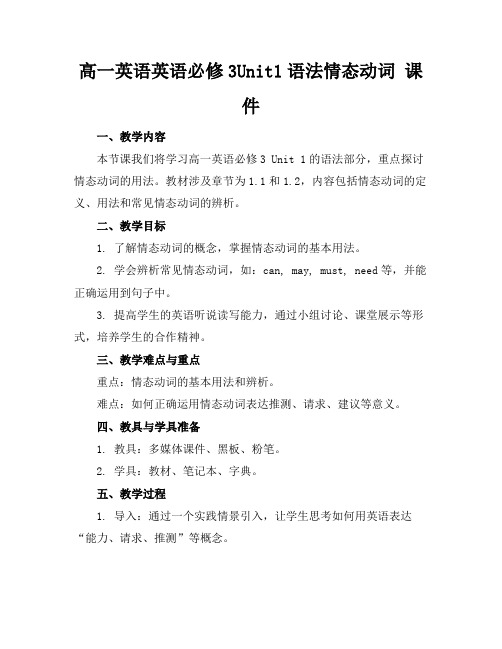
高一英语英语必修3Unit1语法情态动词课件一、教学内容本节课我们将学习高一英语必修3 Unit 1的语法部分,重点探讨情态动词的用法。
教材涉及章节为1.1和1.2,内容包括情态动词的定义、用法和常见情态动词的辨析。
二、教学目标1. 了解情态动词的概念,掌握情态动词的基本用法。
2. 学会辨析常见情态动词,如:can, may, must, need等,并能正确运用到句子中。
3. 提高学生的英语听说读写能力,通过小组讨论、课堂展示等形式,培养学生的合作精神。
三、教学难点与重点重点:情态动词的基本用法和辨析。
难点:如何正确运用情态动词表达推测、请求、建议等意义。
四、教具与学具准备1. 教具:多媒体课件、黑板、粉笔。
2. 学具:教材、笔记本、字典。
五、教学过程1. 导入:通过一个实践情景引入,让学生思考如何用英语表达“能力、请求、推测”等概念。
2. 新课内容:讲解情态动词的定义、用法,通过例句展示不同情态动词的用法。
3. 例题讲解:分析教材中的例题,讲解解题思路,引导学生正确使用情态动词。
4. 随堂练习:布置教材中的练习题,让学生当堂完成,并及时给予反馈。
5. 小组讨论:让学生分成小组,讨论如何在不同情境下使用情态动词,并进行课堂展示。
7. 作业布置:布置课后作业,要求学生运用所学知识完成。
六、板书设计1. 情态动词的定义和用法2. 常见情态动词的辨析3. 课堂练习和答案七、作业设计1. 作业题目:(1)完成教材1.2中的练习题。
(2)用情态动词编写一段对话,描述一个实践情景。
2. 答案:八、课后反思及拓展延伸1. 反思:本节课的教学效果,学生的掌握程度,以及教学过程中的不足。
2. 拓展延伸:鼓励学生在课后阅读英语文章,观察情态动词在不同语境下的使用,提高英语实际运用能力。
同时,布置一道拓展题目,让学生尝试用所学情态动词描述一个更复杂的实践情景。
重点和难点解析一、教学难点与重点1. 重点:情态动词的基本用法和辨析。
高中英语语法之情态动词--高一英语必修三Unit2教案

Unit 2 Healthy eatingGrammar Modal VerbsⅠ.Knowledge aims :Teaching goals:1. Get students to know more about modal verbs.2. Let students learn the use of ought to, need, needn’t, don’t have to, mustn’t. Abilities goals:Enable students to use modal verbs + have done correctly and properly according to the context.Emotion goals:1. Get students to become interested in grammar learning.2. Develop students’ sense of group cooperation.Ⅱ. Teaching importance:1.The usage of the modal verbs.2.The sameness and difference among these modal verbs.3.Correctly understand the change the modal verbs bring to the sentence, that is ,their functions.Ⅲ.Teaching difficulties:Enable students to learn how to use them correctly.IV. Teaching methods:1. Task-based teaching and learning2. Discovering3. DiscussionV. Teaching Procedures:Step 1 Leading-inT: First listen to an English song and fill in the blanks with modal verbs.Step 2 Revision1. What modal verbs have you learned?can/ couldmay/ mightwill/ wouldshall/ shouldmust/ have toought to / need2. The students read the sentences and fill in the blanks with the proper modal verbs we have learned.Step3 Grammar learningAsk the students: Recently, a TV series is very popular. Do you know what it is? Have you seen it? Who are main characters? Who can introduce briefly? Observe the sentences carefully and finish the following task.1.DiscoveringPlease think about it individually and fill in the form in pencil.2.Exchange what you have discovered with your deskmate and then do some corrections.3.InductionStep4 Discovery1. What can we learn from the TV show?2.Think over and discuss with a partner how each of these modal verbs is being used in the situations. What does each modal verb mean?Duty Necessity Prohibition(禁止) Lack of necessity3. Use the function words above to explain the meaning of the modal verbs. If students have some difficulty, give them a hand.Step5 Practice1. Read the sentences and fill in the blanks with the modal verbs we have just learned.2. Look at the pictures and give some advice. I have given you some key words to help you.Step6 Presentation1. Let students discuss in groups to write down their ideas according to the picturesand key words using the modal verbs they have learned.2. Show their ideas to the studentsStep7 SummarySumming up the use of the modal verbs1).The use of ought to, need, needn’t, don’t have to, mustn’t.2). The use of modal verbs + have doneStep 8 Homework作文:给早恋的同学提几条建议要求:1. 用情态动词和情态动词+ have done2. 字数不得少于80词板书设计Grammar :Modal Verbs I.must have donemay /might have donecan’/couldn’t have donecould have doneshould have doneshouldn’t have doneneedn’t have doneII.ought toneedneedn’tdon’t have tomustn’t。
高一必修三Unit1Grammar情态动词讲解附随堂练习课件(共37张PPT)

• 2. 表示推测 • must表示有根据、有把握的推测,只用于
肯定句。注意体会:must do/be; must be doing; must have done/been.
• He looks so pale. He must be ill.
5.My father’s birthday is coming. What
_s_h_a_l_l___ I get for him?
6.“Who was the man talking with your
teacher?” “I’m not sure. It __m_i_g_h_t_____
be her brother.
3. I haven’t decided where I’m going for my holidays. I _m__a_y__ go to Australia.
4. It is a long time since we met last time. You _s_h_o_u_ld___ come and see us more often.
“或许,大概,可能”之意,一般不用于疑问句。 might表示的可能性比may小。
• Anna may know my phone number.
• He might come tomorrow, but I am not quite sure.
• I couldn't find my key. I might have left it in my office.
• 1. 表示征求对方意见或者请求允许 • May I come in? • You may come if you want to. • She asked if her mother might come to
高一英语英语必修3Unit1语法情态动词课件
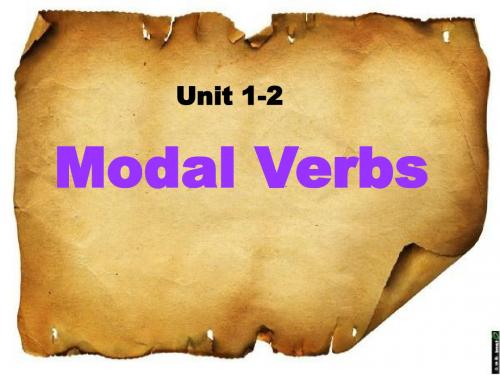
2.Having failed the exam. The little boy __go home and face his mom. A. dares not to B. dares not
C. dare not to
D. dare not
2015年3月12日星期四
21
7.情态动词+have done
keep it till next week if you like.
A. can’t B. mustn’t C. needn’t D. may not
5. Johnny, you ______ play with the knife, you ______ hurt yourself. A. won’t ; can’t
2. 表万一,多位于句首。
Should he come, I would let you know.
.
2015年3月12日星期四
13
5.must的主要用法
1. 必须。must表主观“必须” have to 表客观“不得不” I must go home this Saturday. I’ve got a cold, so I have to see a doctor.
2015年3月12日星期四
B. mustn’t ; may
C. shouldn’t ; must
D. can’t ; shouldn’t
17
6. — Might I watch TV after supper?
— Yes, you ________. A. may B. must C. might D. can
2015年3月12日星期四 7
Might用法
高一英语英语必修3Unit1语法情态动词课件精选

高一英语英语必修3Unit1语法情态动词课件精选一、教学内容本节课选自高一英语必修3 Unit1的语法部分,主要聚焦情态动词的用法。
具体内容包括:1. 教材章节:Unit1 "Festivals around the world"2. 语法内容:情态动词(can, may, must, might, could, should, will, would)的用法及其在不同语境中的意义。
二、教学目标1. 学生能够理解和运用常见的情态动词,表达推测、请求、能力、许可等意义。
2. 学生能在日常交流中,恰当使用情态动词,表达自己的观点和情感。
3. 学生通过学习情态动词,提高对英语语法的理解,为后续学习打下基础。
三、教学难点与重点1. 教学难点:情态动词的词义辨析及在不同语境中的运用。
2. 教学重点:情态动词的基本用法及与其他动词的搭配。
四、教具与学具准备1. 教具:PPT课件、黑板、粉笔、多媒体设备。
2. 学具:英语课本、笔记本、练习本。
五、教学过程1. 实践情景引入(5分钟)利用PPT展示世界各地的节日图片,引导学生讨论不同节日的习俗,引出本节课的主题。
2. 例题讲解(15分钟)通过PPT展示例句,讲解情态动词的基本用法,如推测、能力、请求等,并让学生模仿造句。
3. 随堂练习(10分钟)发放练习纸,让学生根据所学内容完成练习,巩固情态动词的用法。
4. 小组讨论(10分钟)5. 学生展示(5分钟)每组选出一名代表展示讨论成果,其他同学给予评价。
六、板书设计1. 情态动词的基本用法推测:can, may, must, might, could能力:can, be able to请求:can, may, could, would许可:can, may, might2. 例句展示七、作业设计1. 作业题目:根据所学情态动词,完成下列句子。
2. 答案:例句1:If I had a million dollars, I could buy a luxurious house.例句2:We should take public transportation to reduce air pollution.八、课后反思及拓展延伸1. 课后反思:针对本节课的教学效果,教师应反思教学方法是否合适,学生是否掌握了情态动词的用法。
人教版高一英语英语必修3Unit1语法情态动词 (共35张PPT).ppt

2. ---Where is Emma? ---I can’t say for sure where she is, but she___ be out shopping. A. can B. should C. must D. may
3. The room is in a terrible mess; it ____ cleaned. A. can’t have been B. couldn’t be C. may have been D. would be
hotel, but perhaps I have driven her there. (2007 陕西)
A. could
B. must
C. night
D. should
• Will you please take a message for him?
• Would you please tell me your telephone number?
2020年3月27日星期五
16
2.表示习惯或倾向, 意为“总是”,“习惯于”。
eg: • Fish will die without water. • People will talk. (人们总会说闲话。)
eg: Everybody must obey the law.
You mustn’t drive so fast in the street.
2. 表示有把握的猜测。“一定”、“准是” 结构:must be
eg: He must be an honest boy.
★用must 提问,回答方式
肯定回答:yes, please / I’m afraid so 否定回答 :needn’t / don’t have to
- 1、下载文档前请自行甄别文档内容的完整性,平台不提供额外的编辑、内容补充、找答案等附加服务。
- 2、"仅部分预览"的文档,不可在线预览部分如存在完整性等问题,可反馈申请退款(可完整预览的文档不适用该条件!)。
- 3、如文档侵犯您的权益,请联系客服反馈,我们会尽快为您处理(人工客服工作时间:9:00-18:30)。
A. No, you needn’t B. Not, please. C. No, you mustn’t D. No, you won’t
注意:
may I …? 的答语. 肯定: Yes, you may . 否定: No, you mustn’t (语气强硬)
No, you may not. 或 No, you’d better not.
情态动词
常用的情态动词
can (could) may(might) shall(should) will (would)
must dare (dared) need
have to ought to be able to used to
The features(特点) of the modal verbs:
1. Mary ____ be in Paris,for I saw her in
the town only a few minutes ago.
A.mu.shouldn't D.may not
2. My MP4 player isn’t in my bag. Where ____ I have put it? A. can B. must C. should D. would
4. 4.Tbhee fairbelesptorea强d调th成ro功ug地h t做he了h某ote事l very quickly but everyone was able to get out.
2.表“请求,许可”(permission) could用来表示请求的时候比can 更委婉
Can you help me with my English?
❖ (08浙江11)
❖ You
be hungry already— you had lunch only two
hours ago!
❖ A.wouldn’t eedn’t
B.can’t
C.mustn’t
D.n
❖ 答案 B
❖ 解析 句意为:你不可能饿了,你两个小时之前才吃的午饭 !can’t指不可能;mustn’t表猜测时,不能用于否定句;
can ,could 用在肯定句中表示理论上的可能性, “经验之谈”
As a human being, anyone can make a mistake. can ,could用在疑问句中表推测,表示可能性
Can she be in the classroom? can ,could用在否定句中表推测,翻译成“不 可能 ” We thought the story couldn’t be true.
❖ (08湖南28)
❖ You don’t have to know the name of the author to find a book.You find the book by the title.
❖ A.must
B.need
D.would
C.can
❖ 答案 C can表示“可以,能够”。
He has to go home now. He had to look after his sick mother.
在情态动词的使用中, 我们要注意以下考点:
1. 情态动词的基本用法。 2 .情态动词表推测的用法。 3. 情态动词+have done 的用法。
can ,could的用法
1.表“能力”
❖ Needn’t指没有必要。
❖ (08福建24)
❖ It is usually warm in my hometown in March,but
it
be rather cold sometimes.
❖ A.must D.would
B.can
C.should
❖ 答案 B
❖ 解析 must必然,一定;can可能;should应该; would(过去)将,总会。本题提供的语境是“有 时可能会……”。
1. 1I. ccaann/ a表m示a现ble在to的sw能im力.(ability) 2. 2.I ccoouulldd/表w示as 过ab去le的to能cli力mb a tree when I was a
child. 3. be able to 表能力,可用于多种时态 3. I will be able to swim next week.
❖ Peter be really difficult at times even though he’s a nice person in general.
❖ A.shall D.must
B.should
C.can
❖ 答案 C
❖ 解析 句意为:虽然彼得总体上来说是一个好人, 但有时真的难以相处。can在这里不表示主观的推 测,而表示
1. 情态动词本身有词义, 但词义不完全. 2. 不能单独作谓语,只能和动词原形一起构成谓语. 3. 情态动词没有人称和数的变化( 除“have to”).
4H.e没ca有n不/co定ul式d/、mVus-itn/mga、y/Vm-eigdh形t/s式ha.ll/ should/need/dare/dared/will/would/ought to/ used to + work in that factory.
He said I could borrow his bike.
Could I use your bike?
— Could I borrow your dictionary? — Yes, of course you ____. A. might B. will C. can D. should
3.表“可能性”(possibility)P5,4
❖ 客观的可能性。
4.表“request”
❖Could you show me the way to school?
may与might用法
1.表“询问” (might比用may更客气.) May I …? (=Can I … ?) Might I … ? (=Could I … ?) May I borrow your book?
